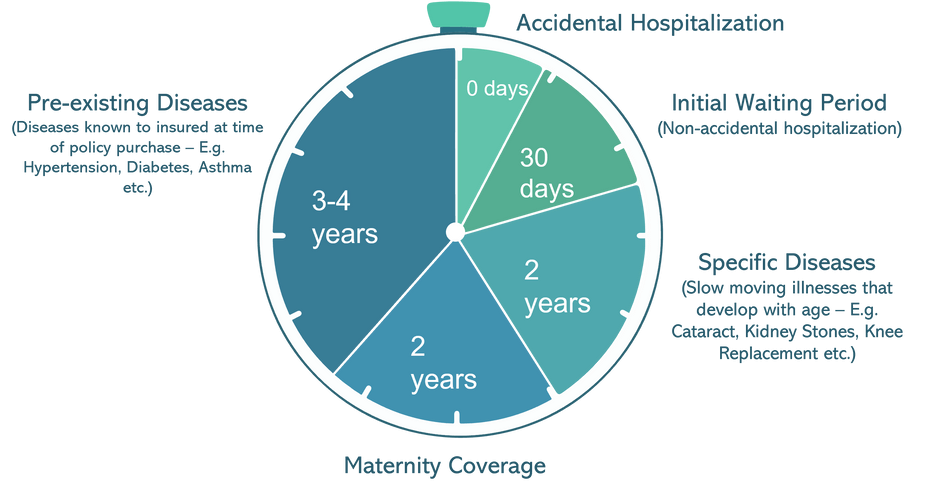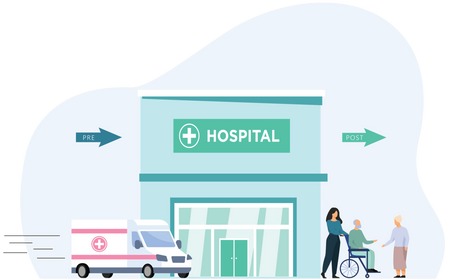This is part of HealthySure’s “How well do you know your corporate Health Insurance benefits”, do read the first part of and the second part of the series to know more about Sum Insured, Family Coverage, Room-rent capping and Disease-capping of your Corporate Health Insurance.
In the third part of our series, let’s explore Co-payment, Waiting Periods and Pre- and post-hospitalization coverage
Table of Contents
Co-Payment
Some health plans mandate that the policyholder bears a small percentage of the total expense of hospitalization and treatment. This clause of co-payment lowers your yearly premium, but might cost you dearly in case of hospitalization.
Who are covered under the co-pay clause?
Under group health insurance, parents cover is often subject to co-payment of 20-30%. Few corporate covers have co-pay even for employee, spouse and children.
So how does insurance co-pay work?
Suppose your corporate cover has a sum insured of ₹5L with a 20% co-payment clause. Say you’re hospitalized where the total expense of your treatment is ₹2L.
Here, the insurance policy will cover you only for 80% of the total cost (₹1.6L). The balance 20% (₹40K) will need to be paid by the employee out of his own pocket.
Percentage Sub-limit
Most corporate covers would have % sub-limit restriction on certain types treatments such as home hospitalization, psychiatric treatments, AYUSH treatments, modern treatments, robotic surgeries etc. In such a case, the coverage under the policy would be restricted upto a % of sum insured as specified for the identified treatments.
Understanding why Percentage Sub-limit is important
Suppose your corporate has offered a policy of ₹5L sum insured with restriction of upto 50% of sum insured on modern treatments. Say you’re hospitalized for cyber knife treatment to cure brain tumour (cyber knife treatments is a painless, non-invasive treatment that destroy tumors through targeted radiation). Say the total expense of your treatment is ₹4L.
Here, the insurance policy will cover you only upto 50% of sum insured cost (₹2.5L). The balance ₹1.5L will need to be paid by the employee out of his own pocket.

What should I do if my corporate health cover has a co-pay clause?
If your corporate health cover has a co-pay or % restriction on certain treatments, it is advisable to buy an independent personal cover to cover for balance expenses.
Waiting Period

Waiting period refers to the amount of time one needs to wait for, after the start of the policy, to be able to use its full benefits.
It may be the initial waiting period or may differ according to specific diseases, pre-existing diseases, or maternity cover.
How does waiting period in your health insurance affects you?

If you have a pre-existing disease (e.g. diabetes or hypertension), you’ll have to wait a prescribed amount of time (e.g. 4 years) before you can claim any treatment or hospitalization related to that disease. Any amount claimed in the meantime will NOT be settled by the insurer.
Why is waiting period necessary?
Waiting period is usually a clause under personal health cover to prevent any policy abuse by the insured. Eg. If a person looking to undergo a kidney stones surgery and is without a policy cover, he would be incentivized to buy a health insurance if there is no waiting period. This would then become an obvious loss to the insurance co.
Do corporate heath insurance have waiting period?
Corporate health covers enjoy the benefit of no waiting period due to universal coverage of all the employees leaving no scope of policy abuse.
Pre and post hospitalization coverage

Most insurers these days cover pre- and post-hospitalization charges of the insured. These include the medical costs such as medicines, lab tests, doctor consultations etc. incurred before getting admitted to and post-discharge from the hospital.
Which tests does pre- and post-hospitalization include?
Pre-hospitalization charges usually include doctor consultations, blood test, urine test, X-Ray etc. incurred say upto 30 days prior to hospitalization. Post-hospitalization charges include post-treatment medications and tests consulted by doctors to ascertain the progress of the patient, say upto 60 days post discharge.
How pre- and post-hospitalization coverage can help you save money?
Suppose the doctor asks you to get a couple of tests done before admitting you to the hospital. The total cost of these tests adds up to ₹10,000. Similarly, if the doctor asks you to keep a track of your progress by getting tested every week after discharge, this can cost you a lot of money out of your own pocket.
However, you can remain stress-free and claim both pre- and post-hospitalization expenses under your health insurance policy upon submission of original bills and other relevant documents to the insurance co.
Are OPD expenses covered under pre- and post-hospitalization charges?
As the name of pre- and post-hospitalization charges suggests, such OPD expenses can be covered only if the insured is hospitalized for minimum 24 hours in a hospital. OPD expenses of routine nature such as common cold, cough, flu etc. usually cannot be claimed under health insurance.
Healthysure Pro-Tip
Choose a policy that offers pre- and post-hospitalization coverage for a longer time span. Standard coverage under corporate health covers is 30/60 days, which on higher side can go upto 60/90 days.
Follow our LinkedIn page for more such updates on Healthcare and Insurance




